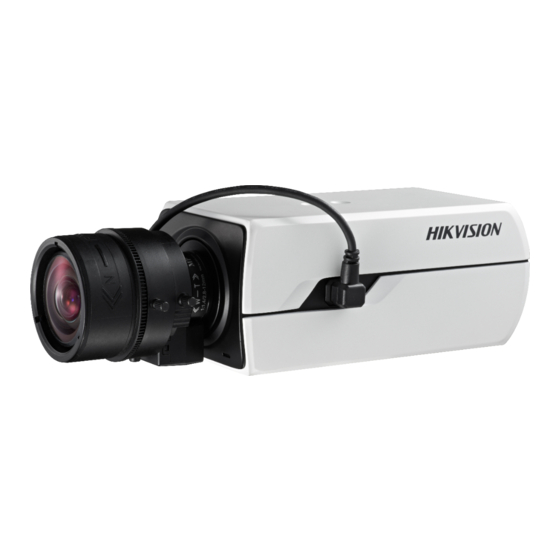
Table of Contents
Advertisement
Quick Links
TURBO HD
4K Series Box Camera
User Manual
User Manual
Thank you for purchasing our product. If there are any
questions, or requests, do not hesitate to contact the
dealer.
This manual applies to the models below:
Model
DS-2CE37U8T-A
This manual may contain technical incorrect places or
printing errors, and the content is subject to change
without notice. The updates will be added to the new
version of this manual. We will readily improve or update
the products or procedures described in the manual.
0100001070930
Advertisement
Table of Contents

Summary of Contents for HIKVISION DS-2CE37U8T-A
- Page 1 This manual applies to the models below: Model DS-2CE37U8T-A This manual may contain technical incorrect places or printing errors, and the content is subject to change without notice. The updates will be added to the new version of this manual.
-
Page 2: Regulatory Information
Regulatory Information FCC Information Please take attention that changes or modification not expressly approved by the party responsible for compliance could void the user’s authority to operate the equipment. FCC compliance: This equipment has been tested and found to comply with the limits for a Class A digital device, pursuant to part 15 of the FCC Rules. - Page 3 Safety Instruction These instructions are intended to ensure that user can use the product correctly to avoid danger or property loss. The precaution measure is divided into “Warnings” and “Cautions”. Warnings: Serious injury or death may occur if any of the warnings are neglected.
- Page 4 While in delivery, the camera shall be packed in its original packing, or packing of the same texture. Mark Description Table 0-1 Mark Description Mark Description DC Voltage 1 Introduction 1.1 Product Features The camera is applicable for indoor conditions, and the application scenarios include warehouse, underground parking lot, bar, etc.
-
Page 5: Installation
2 Installation Before you start: Make sure that the device in the package is in good condition and all the assembly parts are included. Make sure that all the related equipment is power-off during the installation. Check the specification of the products for the ... - Page 6 3. (Optional) Drill the cable hole in the wall, if you route the cable through the cable hole. Figure 2-1 The Drill Template 4. Route the cables through the silicone rubber plug in the wall mount, and the cable hole (optional). Figure 2-2 Rout the Cable 5.
- Page 7 Figure 2-5 Angle Adjustment 1). Loosen the tilt adjusting screw to adjust the tilt angle from 0° to 90°. 2). Tighten the tilt adjusting screw. 3). Loosen the pan adjusting screw to adjust the pan angle from 0° to 360°. 4).
-
Page 8: Menu Description
Figure 2-8 Tighten the Camera to the Mount 6. Connect the corresponding cables, such as power cord, and video cable, and route the cable. 7. Power on the camera to check whether the image on the monitor is gotten from the optimum angle. If not, adjust the camera according to the figure below to get an optimum angle. -
Page 9: Video Format
Lens Type Scene Shutter Exposure Mode Exposure Slow Shutter Video Format Auto White Manual Balance Color Auto Day/Night Contrast Main Menu Sharpness Video Settings Saturation 3D DNR Mirror Defog RS-485 Functions Language Factory Default Cancel Save & Exit Figure 3-2 Main Menu Overview 5. - Page 10 Scene You can select Indoor, or Outdoor as the working environment. Indoor: Applicable to the indoor environment whose color temperature changes slightly Outdoor: Applicable to the outdoor environment whose color temperature changes obviously. Shutter Shutter denotes the speed of the shutter. PAL: AUTO, 1/25 s, 1/50 s, 1/100 s, 1/150 s, 1/200 s, 1/250 s, 1/500 s, 1/750 s, 1/1k s, 1/2k s, 1/4k s, 1/5k s, and 1/10k s are selectable.
- Page 11 Auto Under Auto mode, white balance is being adjusted automatically according to the color temperature of the scene illumination. Manual Click Iris+ to enter the submenu, you can set the R Gain/B Gain value from 1 to 255 to adjust the shades of red/blue color of the image.
- Page 12 Sharpness Sharpness determines the amount of detail an imaging system can reproduce. You can set the Sharpness value from 1 to 10. Saturation Adjust this feature to change the saturation of the color. The value ranges from 1 to 10. 3D DNR (Digital Noise Reduction) The 3D DNR function can decrease the noise effect, especially when capturing moving images in poor light...













Need help?
Do you have a question about the DS-2CE37U8T-A and is the answer not in the manual?
Questions and answers